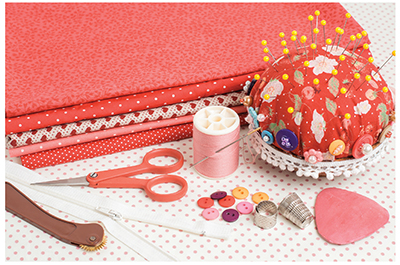Selecting Interfacings, Underlinings, and Linings
Guide C-208
Revised by Jennah McKinley
College of Agricultural, Consumer and Environmental Sciences, New Mexico State University
Author: Extension Family and Consumer Sciences Agent, Eddy County Extension Office, New Mexico State University. (Print friendly PDF)
Fashion sets the silhouette or shape of a garment. A garment’s silhouette can take many forms, from soft and drapey to crisp and firm, and the construction techniques used for shaping and reinforcing certain areas of the garment are selected to create that silhouette.
Methods for creating a garment silhouette vary according to the fashion fabric, the type of garment, and the care procedures for the finished garment.

(© Xiebiyun | Dreamstime.com)
Shaping Garments
The silhouette of a garment can be shaped and reinforced with interfacing and/or underlining.
Interfacing
Interfacing is a layer of knitted, woven, or nonwoven fabric placed between the garment fabric and facing to reinforce, add body, and guarantee crispness. Interfacing improves a garment’s appearance and preserves its shape. Interfacing is usually cut by a special pattern or by the facing pattern pieces.
Interfacing usually is used for the front opening edges, especially where there are buttons and buttonholes, collars, cuffs, waistbands, and pocket flaps. Any area where stretching or loss of crispness from wear will occur should be interfaced.
Different areas of a garment may require different kinds of interfacing fabric. Select interfacing from knitted, woven, and nonwoven fabrics that can be sewn in or fused to the garment. Consider the weight of the garment fabric and select an interfacing that is the same weight or lighter. When selecting a fusible interfacing, use a lighter weight than the fabric needs because fusing often stiffens the fabric. You may want to use an interfacing fabric that is heavier than the garment fabric for special effects.
Consider the care procedures for the garment fabric when you select interfacing. An interfacing should have the same or similar care procedures. For example, if the garment fabrics are permanent press, use permanent press interfacing.
Underlining
Underlining is a backing for the garment fabric. Cut underlining from the same pattern pieces as the garment. Stitch the pieces to the garment fabric, then treat the two as one during garment construction.
Underlining is used to add body to garment fabric and to support major design lines. It adds strength and durability to the garment. Underlining can be used to add opaqueness to fabric or to create a special color effect for sheer fabrics. Garments that are underlined are less likely to become baggy in stress areas or to have pulling along seamlines.
Underlining does not add crispness or stiffness to a garment. It does not finish the inside of the garment. Knits usually are underlined with only knit underlining; a woven fabric underlining would limit the stretchability of the knit.
Underlining fabric should be similar to the fashion fabric in terms of wearability, drapability, weight, and care required. Its weight should be the same or lighter; the underlining should not overpower the characteristics of the garment fabric.
Patterns seldom specify the use of underlining, but it should be used with garment fabric that appears likely to lose its shape with regular wear. In some instances, only special parts of a garment are underlined—the skirt back or the knee area of pants. Garments may require both interfacing and underlining to create the desired silhouette. When selecting fabrics to be used together, be careful to select those with similar durability and care procedures.
Line to Preserve Garment Shape
After the garment’s silhouette has been established with interfacing or underlining or both, preserve it.
A lining will help preserve garment shape, especially if it is made slightly smaller than the garment. Use a lining to add a feeling of luxury to the garment, protect the garment fabric from body oils, and make wearing a slip unnecessary. Lining gives a finished appearance to the inside of a garment. Wrinkle resistance often is increased when a garment is lined. If the lining fabric is “antistatic,” the lining can help eliminate garment cling.
A lining should not add shape to the garment. It is made as a separate unit, then placed inside the garment wrong side to wrong side and attached along the garment edges. Because the lining covers the garment seam allowances, a seam finish is seldom required unless the fabric ravels badly.
Select firmly woven or knitted lining fabric that is lighter weight than the garment fabric. It should also be soft, pliable, and smooth, so the finished garment can slip over the body easily.
For a knit garment, the lining fabric may be woven or knit. A woven lining will limit the garment’s stretchiness. A knit lining will finish the inside of the garment, but will not affect the fabric’s stretchiness.
Select lining fabrics in a color to harmonize or contrast with the garment fabric. However, the lining color should not affect the outside appearance of the finished garment. A printed lining fabric adds a very special fashion touch to any garment.
Be sure the lining fabric has care requirements similar to the garment fabric. Use a fabric protector like Scotchgard on lining fabrics to reduce dry cleaning bills. Durability is also important; the lining fabric should have a wear life as long as that of the garment fabric.
Yardage Required
The pattern envelope usually indicates the amount of interfacing required. Instead of purchasing small amounts of interfacing for individual projects, it may be more economical to purchase at least a yard or more to keep on hand. Less fabric is wasted when pattern pieces are cut from longer lengths of interfacing.
Lining requirements for jackets and coats can also be found on the pattern envelope. Yardage for underlinings and linings for dresses may not be given. In such cases, purchase the same amount required for the garment.
Table 1 lists the types of interfacing, underlining, and lining fabrics suitable for popular garment fabrics.
|
Table 1. Interfacing, Underlining, and Lining Options for Popular Garment Fabrics |
|||
|
Garment Fabric |
Interfacing |
Underlining |
Lining |
|
Very light to lightweight cottons, silks, blends, synthetics, voile, lawn, pure silk, lace, sheer, crepe, challis |
Lightweight interfacing with soft or crisp finish, permanent press; soft: batiste-type woven or regular, all-bias or one-way, stretch, nonwoven; crisp: organdy, organza (for silk), lightweight nonwoven |
Lightweight synthetic underlining with soft or crisp finish, permanent press; soft: cotton or synthetic sheath lining; crisp: organdy, organza (for silk), lightweight nonwoven |
Silk-like rayon or polyester lining, china silk, acetate, sheath lining, lightweight crepe (antistatic) |
|
Medium-weight cottons, synthetics, blends, silks, wools, linens, denim, homespun, poplin, silk linen, flannel |
Medium-weight interfacing with soft or crisp finish, permanent press; soft: regular, all-bias or one-way stretch. Nonwoven, medium-weight woven; crisp: medium-weight nonwoven, lightweight hair canvas, canvas interfacing, iron-on woven or nonwoven |
Medium-weight synthetic underlining with soft or crisp finish, permanent press; soft: lightweight nonwoven; crisp: medium-weight taffeta or nonwoven |
Acetate sheath lining, polyster lining, medium crepe, silk surah, polished cotton (for cottons and linens), taffeta (antistatic) |
|
Heavyweight cottons, linens, wools, blends, corduroy, brocade, tweed |
Medium- or heavyweight interfacing with soft or crisp finish, permanent press; soft: soft hair canvas; crisp: heavyweight nonwoven, medium- or heavyweight crisp hair canvas or canvas interfacing, wool/synthetic blends, iron-on woven or nonwoven |
Medium- or heavyweight synthetic underlining with soft or crisp finish, permanent press; crisp: medium- or heavyweight nonwoven |
Heavyweight taffeta, satin, crepe-back satin, medium crepe, silk shantung, rayon twill (antistatic) |
|
Knits, jerseys |
Used where stretch is not desired or where support is needed to maintain the shape. Use light or medium fusible knitted, woven, or nonwoven interfacing, permanent press, iron-on nonwoven in regular or stretch types |
Knits are very seldom underlined because it limits their natural stretch |
Linings listed above of the appropriate weight. Swimwear linings should have two-way stretch. The lighter weights have more stretch. |
|
Leather, suede, synthetic leather |
Woven or nonwoven interfacing, muslin, hair canvas, permanent press |
Usually not needed |
Satin, taffeta, vinyl, rayon twill. May place lining on wrong side of pants front in knee area to prevent stretching. Stitch in leg seams, but leave free at top and bottom. |
Purchasing Tips
Pay very close attention to fiber content and fabric weave since they provide some very important clues about a lining’s durability. If a garment will be worn close to the body—like a dress—be sure the lining is absorbent or “breathable.” This often eliminates some synthetic linings made of polyester, nylon, etc. Rayons, rayon/acetate blends, or cotton may be more comfortable. Purchase or invest in the highest quality lining available.
For Further Reading
C-205: Selecting a Pattern Size for Perfect Fit
https://pubs.nmsu.edu/_c/C205/
C-222: Sleeve Plackets and Bands
https://pubs.nmsu.edu/_c/C222/
C-233: Facings Made Easy
https://pubs.nmsu.edu/_c/C233/
All Clothing Publications Listing
https://pubs.nmsu.edu/_c/
|
Original author: Susan Wright, Extension Clothing Specialist. Subsequently reviewed by Constance Kratzer, Family Resource Management Specialist. |

Jennah McKinley is a Family and Consumer Sciences Agent for NMSU’s Cooperative Extension Service Office in Eddy County. She earned her B.S. in family and consumer sciences education and her M.Ed. in online teaching and learning from NMSU. She specializes in community education and 4-H youth development. Her programs focus on parenting, childcare, nutrition, diabetes education, family resource management, and youth development.
To find more resources for your business, home, or family, visit the College of Agriculture and Home Economics on the World Wide Web at pubs.nmsu.edu
Contents of publications may be freely reproduced for educational purposes. All other rights reserved. For permission to use publications for other purposes, contact pubs@nmsu.edu or the authors listed on the publication.
New Mexico State University is an equal opportunity/affirmative action employer and educator. NMSU and the U.S. Department of Agriculture cooperating.
Revised October 2016


